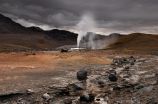New climate stress index model challenges doomsday forecasts for world's coral reefs
Complex model performs better than common temperature threshold predictions
2015-06-01
(Press-News.org) Recent forecasts on the impacts of climate change on the world's coral reefs--especially ones generated from oceanic surface temperature data gathered by satellites--paint a grim picture for the future of the "rainforests of the sea."
A newer and more complex model incorporating data from both environmental factors and field observations of coral responses to stress provides a better forecasting tool than the more widely used models and a more positive future for coral reefs, according to a new study by the Wildlife Conservation Society and other groups.
The study authors point out that, according to the climate stress index model first developed in 2008, coral reefs are responding to more factors than temperature and therefore more resilient to rising temperatures. They conclude that global climate change is the greatest global threat to coral reefs but the future of these ecosystems is more varied than predictions from the more widely used "temperature threshold" models.
The paper titled "Regional coral responses to climate disturbances and warming is predicted by multivariate stress model and not temperature threshold metrics" appears in the online edition of Climatic Change. The authors are: Timothy R. McClanahan of the Wildlife Conservation Society; Joseph Maina of the Wildlife Conservation Society and the Australia Research Council Centre of Excellence for Environmental Decisions; and Mebrahtu Ateweberhan of the Wildlife Conservation Society and the University of Warwick.
"Our new multivariate stress model suggests that the future of coral reefs is considerably more nuanced and spatially complex than predictions arising from the threshold models," said Dr. Tim McClanahan, WCS's Senior Conservation scientist and a co-author on the study. "According to our findings in the Western Indian Ocean, some places will do well and others will not. The key to accurate predictions is using all available environmental data and complementing it with on-the-ground observations on reef cover, coral communities, and other environmental variables that are key to understanding how corals respond to the interaction between all these variables."
In the study, the authors compared the abilities of three common thermal threshold indices against a stress model that includes temperature but also light and water quality and movement variables and used the models to predict coral cover and susceptibility to bleaching during a past large stress event: specifically the 1997-98 coral bleaching event in the Western Indian Ocean. The field information used in the test included a compilation of 10 years of coral community data before the bleaching event, two years after the bleaching event, and data during the period of coral recovery between 2001-2005.
While the three temperature threshold models (sea surface temperature, cumulative thermal stress, and annual thermal stress) were highly variable with little agreement to field data after the 1998 rise in temperature and coral mortality, the multivariate model based on 11environmental variables combined using a fuzzy logic systems revealed a more accurate fit with the recorded coral cover and susceptibility in the recovery period that followed.
"This latest research suggests a more optimistic future for the world's coral reefs," said Dr. Caleb McClennen, Executive Director of WCS's Marine Program. "The ability of certain coral communities to resist and recover from climatic factors provides hope for the future of the oceans. Our imperative is now to seek out and protect those locations that are refuges from climate change, and reduce other human stresses such as fisheries to ensure the long term survival of coral reefs."
INFORMATION:
This research was supported by the John D. and Catherine T. MacArthur Foundation, the Western Indian Ocean Marine Science Association, and the World Bank Targeted Research Group on Coral Bleaching.
To access the article, go to: http://link.springer.com/article/10.1007/s10584-015-1399-x
[Attachments] See images for this press release:

ELSE PRESS RELEASES FROM THIS DATE:
2015-06-01
PULLMAN, Wash.--A comprehensive study finds organic agriculture is more profitable for farmers than conventional agriculture.
In spite of lower yields, the global study shows that the profit margins for organic agriculture were significantly greater than conventional agriculture. The results show that there's room for organic agriculture to expand and, with its environmental benefits, to contribute a larger share in feeding the world sustainably. Organic agriculture currently accounts for only one percent of agriculture globally.
The study, published this week in the ...
2015-06-01
Planet Earth may contain millions fewer species than previously thought and estimates are converging, according to research led by Griffith University (Queensland, Australia).
In a paper published by the US-based journal Proceedings of the National Academy of Sciences (PNAS), Professor Nigel Stork of Griffith's Environmental Futures Research Institute reveals findings that narrow global species estimates for beetles, insects and terrestrial arthropods.
The research features an entirely new method of species calculation derived from samples of beetles from the comprehensive ...
2015-06-01
June 1, 2015 CHAPEL HILL, NC - In the beginning, there were simple chemicals. And they produced amino acids that eventually became the proteins necessary to create single cells. And the single cells became plants and animals. Recent research is revealing how the primordial soup created the amino acid building blocks, and there is widespread scientific consensus on the evolution from the first cell into plants and animals. But it's still a mystery how the building blocks were first assembled into the proteins that formed the machinery of all cells. Now, two long-time University ...
2015-06-01
Today's computer chips pack billions of tiny transistors onto a plate of silicon within the width of a fingernail. Each transistor, just tens of nanometers wide, acts as a switch that, in concert with others, carries out a computer's computations. As dense forests of transistors signal back and forth, they give off heat -- which can fry the electronics, if a chip gets too hot.
Manufacturers commonly apply a classical diffusion theory to gauge a transistor's temperature rise in a computer chip. But now an experiment by MIT engineers suggests that this common theory doesn't ...
2015-06-01
Bacteria and viruses have an obvious role in causing infectious diseases, but microbes have also been identified as the surprising cause of other illnesses, including cervical cancer (Human papilloma virus) and stomach ulcers (H. pylori bacteria).
A new study by University of Iowa microbiologists now suggests that bacteria may even be a cause of one of the most prevalent diseases of our time - Type 2 diabetes.
The research team led by Patrick Schlievert, PhD, professor and DEO of microbiology at the UI Carver College of Medicine, found that prolonged exposure to a toxin ...
2015-06-01
As the world's population of older adults increases, so do conversations around successful aging -- including seniors' physical, mental and social well-being.
A variety of factors can impact aging adults' quality of life. Two big ones, according to new research from the University of Arizona, are the health and cognitive functioning of a person's spouse.
Analyzing data from more than 8,000 married couples -- with an average age in the early 60s -- researchers found that the physical health and cognitive functioning of a person's spouse can significantly affect a person's ...
2015-06-01
A team of scientists at Virginia Commonwealth University has synthesized a powerful new magnetic material that could reduce the dependence of the United States and other nations on rare earth elements produced by China.
"The discovery opens the pathway to systematically improving the new material to outperform the current permanent magnets," said Shiv Khanna, Ph.D., a commonwealth professor in the Department of Physics in the College of Humanities and Sciences.
The new material consists of nanoparticles containing iron, cobalt and carbon atoms with a magnetic domain ...
2015-06-01
COLLEGE PARK, Md. -- The introduction of Craigslist led to an increase in HIV-infection cases of 13.5 percent in Florida over a four-year period, according to a new study conducted at the University of Maryland's Robert H. Smith School of Business. The estimated medical costs for those patients will amount to $710 million over the course of their lives.
Online hookup sites have made it easier for people to have casual sex -- and also easier to transmit sexually transmitted diseases. The new study measured the magnitude of the effect of one platform on HIV infection rates ...
2015-06-01
Selling one's body to provide another person with sexual pleasure and selling organs to restore another person's health are generally prohibited in North America on moral grounds, but two new University of Toronto Mississauga studies illustrate how additional information about the societal benefits of such transactions can have an impact on public approval.
The research, conducted by Professor Nicola Lacetera of the University of Toronto (Institute for Management and Innovation, U of T Mississauga, with a cross-appointment to the Rotman School of Management) and his ...
2015-06-01
Going into space might wreak havoc on our bodies, but a new set of microgravity experiments may help shed light on new approaches for treating cartilage diseases on Earth. In a new research report published in the June 2015 issue of The FASEB Journal, a team of European scientists suggests that our cartilage--tissue that serves as a cushion between bones--might be able to survive microgravity relatively unscathed. Specifically, when in a microgravity environment, chondrocytes (a main component of cartilage) were more stable and showed only moderate alterations in shape ...
LAST 30 PRESS RELEASES:
[Press-News.org] New climate stress index model challenges doomsday forecasts for world's coral reefs
Complex model performs better than common temperature threshold predictions


